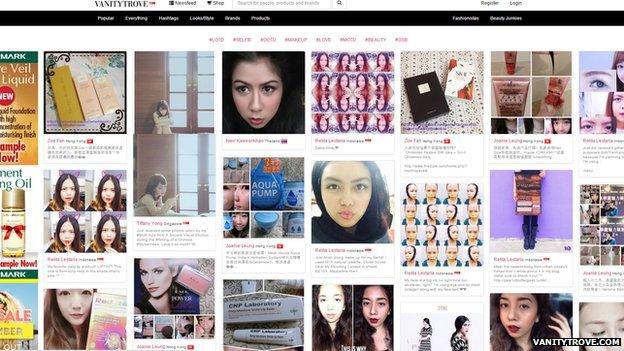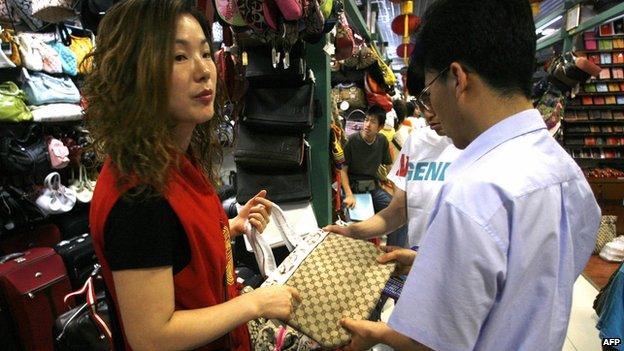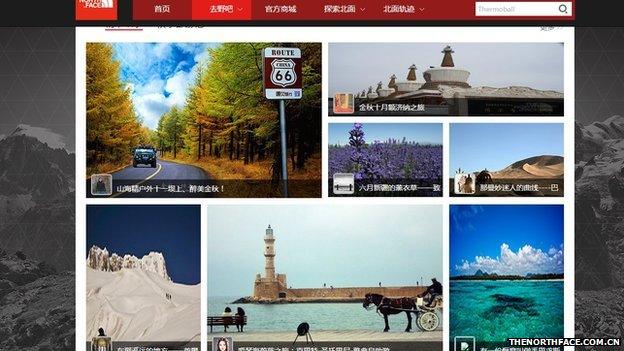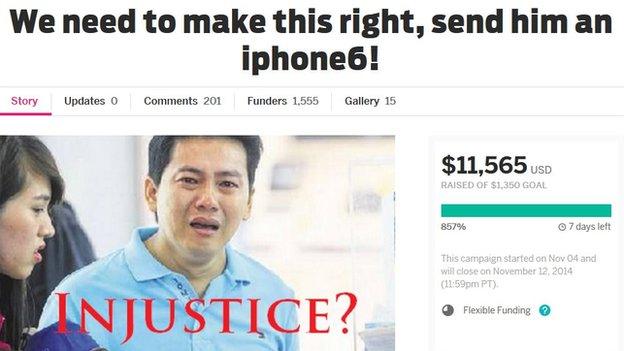Asians flock to social networks for shopping sprees
- Published

Dora's become a fashion icon in Singapore influencing young women's shopping habits
Singaporean student Dora Soh posts her "outfit of the day" online every day, to connect with fellow fashionistas and inspire her nearly 10,000 followers on Instagram.
The 22-year-old's shopping habits have become so influential that online retailers are now sponsoring her to wear their clothes, in hopes that her posts will boost their brand and sales.

Online retailers sponsoring Dora include Singaporean brands The Tinsel Rack, MGP and Mint & Ooak
"On social media, I can interact with strangers and share fashion inspiration by following their accounts and liking their photos," Ms Soh says.
While this sounds like a simple formula to keep up with the latest fashion trends, the avid shopper is at the forefront of a rapidly growing business in Asia - social shopping.
Global retailers are pulling out all the stops to increase their presence on social networks with technology that allows you to broadcast your latest fashion find online, even before it rings through the register.
For example, on Singapore-based social network and shopping website clozette.co, external, users can upload a picture of an item, or focus in on someone else's post, and hit search to find similar outfits for sale.
It is as exact as narrowing in on nail art on someone's finger nails, to search on the website's database of two million items from nearly 5,000 global brands.
"I truly believe we're the first company in the world to do that - intelligent visual recognition," says the website's co-founder and chief executive Roger Yuen.
Social platforms take off
Mr Yuen says growth has skyrocketed on his social media platform, which allows users to create and share their personal wardrobes, as well as buy and sell items from each other and retailers in Asia.
"We have close to 400,000 registered members in the region, and as a company we have a reach of about seven million unique users a month," he says.
The firm launched in 2010 with just under 80,000 users in its first year.

Users can create their own virtual wardrobes or raid through others' to find the latest fashion trends
Singapore based beauty box start-up Vanitytrove.com/sg, external has also seen tremendous growth since it launched its user content-driven platform earlier this year.
Co-founder and chief executive Douglas Gan says about 100-150 new members join the website every day, to browse or post about new products, and chat with like-minded beauty experts.
"We have over 60,000 female members on the platform in Singapore, Indonesia and Thailand," he says. "We figured that if we want consumers to make a conscious decision before they buy something, we should give them a platform."

Users share makeup tips and beauty product must-haves on Vanitytrove
'Word of mouth'
Rapid growth for such fashion-based social networks is not surprising considering recent figures that showed more and more Asians are turning to social media to shape their shopping habits, outpacing other regions of the world.
In a study of 10,000 consumers worldwide, consulting firm AT Kearney found over 95% of people aged between 16 and 45 in China said the chatter on social networks has at some point influenced their online shopping decisions.
Meanwhile, 61% of Chinese respondents said they "frequently" based purchases on what was happening in their social network - almost double the global average of 32%.
In consumer giant India, over 82% of people aged 16-35 said happenings on their social network influenced their buying habits.
Even among the older generation - those aged 65 and over - more than a quarter said their purchases were frequently influenced by social media - much higher than the global average of 5% for that age group.

Figures suggest people in Asia use social media to help them decide what to buy more than anywhere else
Torsten Stocker, Shanghai-based partner at AT Kearney, says word of mouth referrals is the major reason why more Asians rely on social media for shopping, in a world of fake goods and knock-offs.
"There's obviously a history of information control, particularly in China, and I think that extends to some extent to advertising," he says.
"I think there's also a high prevalence of counterfeit, fake and low quality goods - so that it automatically reduces the trust people have in official communication."
Trusting someone who has your best interests in mind, like a close friend or acquaintance, or even someone that is slightly more removed but in your network, is much more compelling, he adds
"If you look at China in particular, there's been so many food scandals, and so many items that may be counterfeit, and may not deliver what they promise. In general the level of trust [in retailers] is lower."

Asian consumers look for reassurance when shopping to ensure they are getting authentic merchandise
Retailers' virtual push
As a result, a lot of consumer goods companies and retailers in Asia are trying to engage with consumers through social media, and create word of mouth in the virtual world.
Retailers that have been successful in creating a buzz online are using a range of tactics from promising shoppers discounts if they post "selfies" wearing their merchandise, to creating online communities based on competitions or events.
Outdoor clothing outlet The North Face's strategy in China this year gained momentum after it launched a competition for consumers to be "The Next Explorer", and win a trip to the US.
The competition resulted in more than 200,000 new members to its online community, where participants talk about products and connect with each other to organise events such as hiking trips.

Members post about adventure trips they have taken on The North Face Chinese website
"It has taken on a life of its own. North Face is behind it, but it's not necessarily advertising for its products," says Mr Stocker.
"It's made them more visible, and helped create more interest in the category... and hopefully people will buy more products."
The North Face sales in China jumped more than 20% in 2013 from the year before.
Meanwhile, as retailers try to come up with innovative ways to engage with consumers online, Singaporean online shopper Chelsea Lin says that overall, it is just easier to get more feedback on purchases through social networks versus going into a physical store.
"It becomes quite addictive, to the point where it's a weekly thing that I would buy something," the 30-year-old office worker says.
"It's like you can shop everyday if you shop online."
- Published11 November 2014

- Published14 August 2014

- Published6 November 2014
